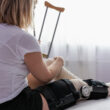According to a prevalent myth, it’s normal for young female competitive athletes to lose their periods, also known as experiencing exercise-induced amenorrhea. The truth is, while it may be common to lose one’s period because of over-exercise, under-eating, or a combination of both, it is neither normal nor healthy. In order to optimize young female athletes’ health, we need to teach them how to train with their female bodies in mind; that is, to train like women rather than like men. Cycle syncing is a powerful way for female athletes to work with, rather than against, their bodies as they train and perform competitively.
What causes exercise-induced amenorrhea?
In a Cleveland Clinic article, registered dietitian Katie Patton commented, “Amenorrhea can be a sign of exercise-induced anorexia related to energy deprivation from not eating enough, from exercising too much, or from a combination of the two.” As indicated by this telling article in Runner’s World, amenorrhea indicates a profound mismatch between calories consumed and energy expended.
The mismatch is the key, rather than some specific amount of daily or weekly exercise or calories burned, that tips a woman into amenorrhea. If a woman consistently eats hundreds of fewer calories than she burns and she has inadequate fat stores, her body goes into energy-conserving starvation mode. The brain no longer sends signals for normal, healthy hormonal processes like ovulation and menstruation. According to Patton, “female athletes who are most susceptible to restricting calorie intake are those who are involved in excessive exercise, play sports that require weight checks or are involved in sports that benefit from a leaner body composition [think runners or soccer players].”
Is losing your period from exercise really that big of a problem?
Interestingly, not having a period isn’t so much the problem with exercised-induced amenorrhea. The bigger issue concerns what a lack of periods likely indicates: If a woman isn’t having her period, she’s very possibly not ovulating. Not ovulating is not good.
As we’ve covered extensively in the past, ovulation is an indicator of overall health in the body. Ovulation is so important that it’s considered a fifth vital sign for women, and with good reason. Ovulation impacts your brain and emotional health as well as your bones, heart, and immune system, as we’ve covered at length here, here, here, and here, and summarized succinctly in this short video.
Furthermore, amenorrhea isn’t typically a standalone problem in female athletes, but rather one of a trio of concerning, interconnected health conditions that make up the “Female Athlete Triad” (the other two are bone loss/osteoporosis and disordered eating). Retired elite runner Lauren Fleshman shared in a ‘Dear Younger Me’ blog post, “If you get to the dips and valleys and fight your body, starve your body, attempt to outsmart it, you will suffer. You will lose your period. You will get faster at first. And then you will get injured.”
The effects of the Triad can plague women long-term. And while little research has been done on the topic, one wonders whether exercise-induced amenorrhea can cause long-term reproductive problems such as hormonal deficiency-related infertility.
Birth control compounds the problem(s)
Unfortunately, most mainstream articles touching on exercise-induced amenorrhea fail to mention that hormonal birth control, which some women experiencing amenorrhea are placed on to “regulate” their cycles, can make things much worse–not to mention the fact that hormonal birth control can’t actually “regulate” your cycle at all, and that pill bleeds will disguise the fact that you’re not regularly ovulating and menstruating as you should.
Birth control pills have a side effect of decreased bone density, leading to increased risk of fracture, which athletes experiencing amenorrhea are already at risk for. This is particularly concerning since women’s bone density should actually be at its peak during their early to mid 20s. In 2019, The New York Times ran a piece on elite runner Mary Cain, once called “the fastest girl in America.” Cain shared her story of suffering emotional and mental abuse by her coach in Nike’s elite running training program. Put on hormonal birth control to lose weight, Cain experienced five broken bones in three years.
What’s more, hormonal birth control use can deplete key nutrients including Vitamins C, B2, B6, folate, Vitamin E, Magnesium, Selenium, and Zinc. These nutritional deficiencies can be particularly pronounced in this population that is already malnourished to some extent, as evidenced by the amenorrhea.
Finally, hormonal contraceptive use has been linked to new onset of depressive and even suicidal symptoms, and the risk is highest in teens and young women. The compounding effect of taking medications that negatively impact one’s mental health on top of existing struggles with disordered eating and tremendous pressures to perform athletically (and academically as well, in the case of high school and college athletes) can be disastrous. Track star Cain was pushed to the brink, cutting herself and suffering from suicidal ideation before quitting the Nike program and gradually beginning to heal.
Avoiding exercise-induced amenorrhea with nutrition tailored for the needs of the female body
Besides stopping (or never starting) hormonal birth control use, female athletes can take proactive steps to maintain a healthy weight and eating habits. For optimal health, registered dietitian Katie Patton suggests that female athletes:
- Eat three full meals each day;
- Balance meals with carbohydrates, protein, and fat;
- Never omit certain food groups, such as fats (omitting food groups can be a sign of disordered eating);
- Eat within 30 to 60 minutes of finishing all workouts;
- Eat post-workout meals high in carbohydrates and moderate in protein (some good examples include sandwich & fruit, bagel with peanut butter and chocolate milk, energy bar and yogurt with granola, or spaghetti with meatballs, salad and fruit);
- Have a minimum of three carbohydrate-rich snacks throughout the day;
- When workouts last more than 90 minutes, eat 15 grams of carbohydrates or drink a sports beverage every 15 to 30 minutes;
- Consume adequate amounts of calcium daily (i.e., 1,000 to 1,300 mg per day from sources like milk, yogurt, cheese, calcium-fortified orange juice, and dark green leafy lettuce).
(Source: Cleveland Clinic)
Women should train like women, not men
As The New York Times exposé on Nike’s running program noted, “Women and girls are being forced to meet athletic standards that are based on how men and boys develop. If you try to make a girl fit a boy’s development timeline, her body is at risk of breaking down.” As board certified OB/GYN and ABC News Chief Medical Correspondent Dr. Jennifer Ashton observed, “The fact is, female athletes are biologically, hormonally, and physically different, and the sooner that reality is embraced instead of resisted, the more potential exists for that athlete to optimize her training behaviors.”
A far superior alternative
Fortunately, some elite athletes are beginning to embrace the reality Dr. Ashton talks about. For example, in 2019, the U.S. Women’s National Team made headlines for more than their World Cup victory. Coach Dawn Scott told Good Morning America that each player had a tailor-made training schedule including workouts, nutrition, and more, based on where she was in her cycle as identified by data from months of period tracking. The basic concept behind the individualized plans is “cycle syncing,” a term coined by women’s health expert Alisa Vitti in reference to “the practice of eating, exercising and aligning your schedule with the different phases of your natural menstrual cycle” as noted by Natural Womanhood’s Hanna Cox.
Research suggests that cycle syncing could be particularly beneficial for female athletes since cycle phases may impact injury risk. This study found that “Injury incident rate ratios showed that muscle and tendon injury rates were 88% greater in the late follicular phase compared to the follicular phase, with muscle rupture/tear/strain/cramps and tendon injuries/ruptures occurring over twice as often during the late follicular phase compared to other phases” [1]. More details on cycle syncing can be found here, here, and here.
It’s high-time young women be given the opportunity to hone their skills on the field, in the pool, or on the court in a way that respects the unique needs and attributes of their distinctly female bodies. Now, that would be “healthy competition.”
References:
[1] Martin D, et al. “Injury Incidence Across the Menstrual Cycle in International Footballers.” Front. Sports Act. Living, vol 3, 616999. doi: 10.3389/fspor.2021.616999Additional Reading:
Cycle syncing: how to hack the natural hormonal shifts of your menstrual cycle
Natural Womanhood book review: In the Flo by Alissa Vitti
Can exercise hurt your fertility?
Knee surgery, blood clots, and birth control: The risks young female athletes need to know about











